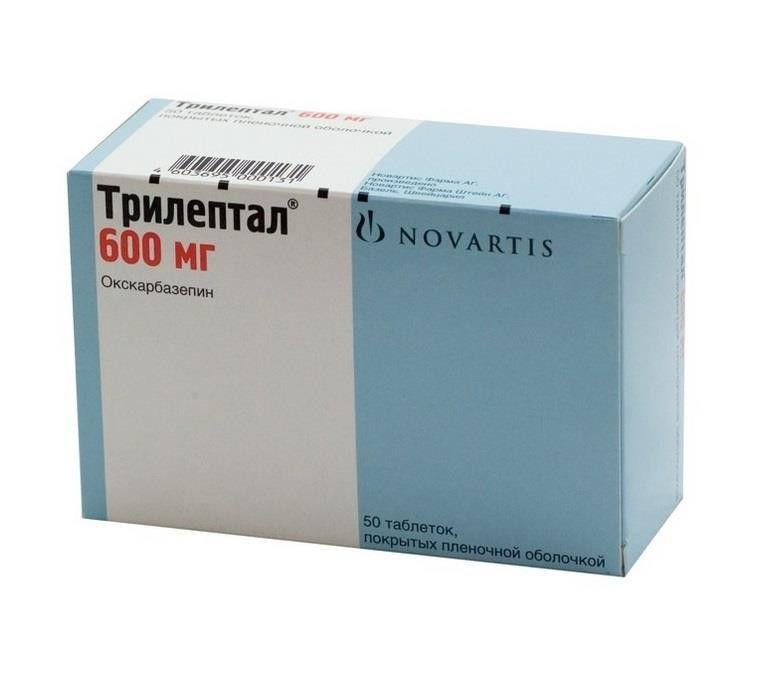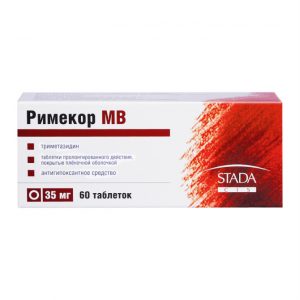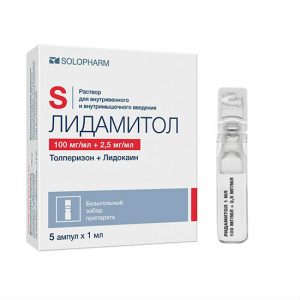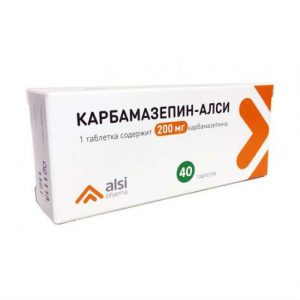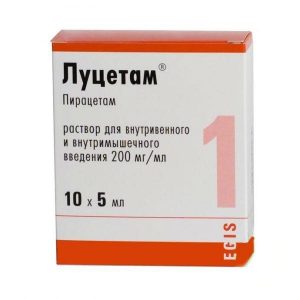Description
Latin name
TRILEPTAL
Release form
Yellow coated tablets, oval, slightly biconvex, with a notch on both sides, TF / TF marking on one side, CG / CG on the other.
packaging 10 pcs – blisters (5) – packs of cardboard.
Pharmacological action
Antiepileptic drug. The pharmacological activity of the drug Trileptal ® (oxcarbazepine) is primarily due to the action of its metabolite, the monohydroxy derivative (MHP). The mechanism of action of oxcarbazepine and its MHP is mainly associated with the blockade of voltage-gated sodium channels, which leads to stabilization of overexcited neuronal membranes, inhibition of serial neuronal discharges and a decrease in synaptic conduction of impulses.
The realization of the anticonvulsant effect of the drug contributes to an increase in the conductivity of potassium ions and modulation of calcium channels activated by a high membrane potential. No significant interactions with brain neurotransmitters or receptor binding have been observed.
In experimental studies it was shown that oxcarbazepine and IHL have a pronounced anticonvulsant effect.
Clinical efficacy of
The effectiveness of the drug Trileptal ® for epileptic seizures has been demonstrated both with monotherapy and with the use of Trileptal as part of combination therapy in children and adults.
The drug Trileptal can be used to replace other antiepileptic drugs in those cases when, when using the latter, a satisfactory therapeutic response to treatment is not achieved.
Pharmacokinetics
Absorption
After oral administration of oxcarbazepine in tablet form quickly and almost completely (> 95%) is absorbed in the gastrointestinal tract and is largely metabolized with the formation of a pharmacologically active metabolite – 10-monohydroxy derivative (IHL). After a single administration of the drug Trileptal ® in the form of coated tablets in a dose of 600 mg by healthy volunteers on an empty stomach, the average Cmax in MHP plasma is 31.5 μmol / L, the average time to reach it (Tmax) is about 5 hours.
After a single dose of the drug Trileptal ® in the form of a suspension in a dose of 600 mg by healthy fasting volunteers, the average Cmax of MHP in blood plasma is 24.9 μmol / L, the average maximum time to reach it is about 6 hours. Film-coated tablets and oral suspension are bioequivalent, since the geometric mean ratio of Cmax and AUC of MHP when using a single dose of oxabazepine in the form of tablets and in the form of a suspension and in equilibrium was in the range from 0.85 to 1.06 (90% confidence interval).
Pharmacokinetic studies have shown that 2% of unchanged oxcarbazepine and 70% of IHL in the blood plasma are determined by the remaining metabolites that are rapidly excreted from the blood plasma.
Eating does not affect the rate and extent of absorption of oxcarbazepine.
Communication with plasma proteins and distribution of
The apparent Vd of IHL is 49 L. Approximately 40% of IHL binds to plasma proteins, mainly albumin. In the therapeutic range, the degree of binding does not depend on the concentration of the drug in serum. Oxcarbazepine and MHP do not bind to 1-acid glycoprotein.
Metabolism
Oxcarbazepine is rapidly metabolized by the cytosolic enzymes of the liver to a pharmacologically active metabolite of IHL, which determines the pharmacological effect of the drug. PGM undergoes further conjugation with glucuronic acid. Minor amounts of MHP (about 4% of the dose) are oxidized to form an inactive metabolite (10,11-dihydroxy derivative (DHP)).
Excretion
Oxcarbazepine is excreted mainly in the form of metabolites, mainly by the kidneys. More than 95% of the dose is excreted by the kidneys in the form of metabolites, less than 1% – unchanged. About 4% of the dose is excreted in the feces. Approximately 80% of the dose is excreted as MHP, both as glucuronides (49%) and as unchanged MHP (27%), inactive BPH is about 3%, oxcarbazepine conjugates – about 13% of the dose. About 4% of the dose is excreted in the feces.
Oxcarbazepine is rapidly excreted from blood plasma, the apparent T1 / 2 is 1.3 – 2.3 hours. Unlike oxcarbazepine, the apparent T1 / 2 MHP is on average 9.3 ± 1.8 hours.
Css MHP in blood plasma is reached for 2-3 days when taken Trileptal ® preparation 2 times / day. In equilibrium, the pharmacokinetic parameters of MHP are linear and dose-dependent in the range of daily doses of 300 mg-2400 mg.
Pharmacokinetics in special clinical cases
Children
IHL clearance, adjusted for body weight, decreases in children with increasing age and body weight, approaching adult clearance. The clearance adjusted for body weight in children aged 1 month to 4 years is on average 93% higher than in adults. Therefore, it is assumed that the AUC of MHP in children of this age group is expected to be 2 times less than that in adults when using the same doses (when adjusted for body weight). The clearance adjusted for body weight in children aged 4 to 12 years is on average 43% higher than in adults. The estimated AUC of IHL in children of this age group is 2/3 of that in adults when using the same doses (when adjusted for body weight). It is assumed that in children aged 13 years and older, due to an increase in body weight, the IHL clearance, adjusted by body weight, corresponds to the IHL clearance in adults.
Pregnant patients
During pregnancy, the body undergoes a number of physiological changes that can lead to a gradual decrease in the level of IHL in blood plasma during this period.
Elderly patients
After taking the drug Trileptal ® once (at a dose of 300 mg) and repeatedly (at a dose of 600 mg / day) in elderly volunteers aged 60-82 years, Cmax and AUC values for MHP were 30-60% higher compared with the same indicators in young volunteers (18-32 years old), which is associated with an age-related decrease in QC.
Gender
There were no differences in pharmacokinetic parameters depending on gender in childhood, adulthood or old age.
Patients with impaired liver function
Pharmacokinetic parameters and metabolism of oxcarbazepine and IHL after a single oral dose of 900 mg were evaluated in healthy volunteers and in patients with impaired liver function. Impaired liver function of mild to moderate degrees do not affect the pharmacokinetic parameters of oxcarbazepine and IHL. The pharmacokinetics of severe liver dysfunction has not been studied.
Patients with impaired renal function
There is a linear relationship between renal clearance of IHL and QC. In patients with impaired renal function (CC less than 30 ml / min) after a single dose of 300 mg of oxcarbazepine T1 / 2, MHP increases by 60-90% (up to 16-19 hours), and AUC increases by 2 times.
Indications
Simple and complex partial epileptic seizures with or without secondary generalization in adults and children aged 1 month and older.
Generalized tonic-clonic epileptic seizures in adults and children 2 years of age and older.
Contraindications
children under 1 month of age
hypersensitivity to oxcarbazepine or any other components of the drug.
Caution is advised to administer the drug to patients with known hypersensitivity to carbamazepine, as in this group of patients, approximately 25-30% of cases may develop hypersensitivity reactions to oxcarbazepine. In patients who do not have a history of hypersensitivity to carbamazepine, the development of hypersensitivity reactions to the drug is also possible, including multiple organ violations.
The use of the drug Trileptal ® in patients with impaired liver function has not been studied, therefore it is necessary to use the drug with caution in this category of patients.
Use in cases of impaired liver function
Dosage adjustment is not required in patients with mild to moderate hepatic impairment. Caution must be exercised when used in patients with severe hepatic impairment.
Application for impaired renal function
For patients with impaired renal function (CC less than 30 ml / min), the recommended initial dose is 300 mg / day, the dose should be increased slowly, with an interval of at least 1 week, until the desired therapeutic response is achieved. Careful monitoring of patients during dose selection is necessary.
Use in children
Use is possible according to the dosage regimen.
Contraindicated in children under 1 month of age.
Use in elderly patients
Special correction of the dosage regimen in this category of patients is necessary for impaired renal function (CC less than 30 ml / min). If there is a risk of developing hyponarrhea, careful monitoring of the sodium content in the blood plasma is necessary.
Use during pregnancy and lactation
Children of patients with epilepsy are more likely than others to develop developmental disorders, including congenital malformations.
Experience with the use of the drug Trileptal ® during pregnancy is limited. Available reports indicate a possible connection between taking the drug during pregnancy and the development of congenital malformations (CMD). The most common malformations in children whose mothers received therapy with Trileptal ® during pregnancy were: atrial septal defect, atrioventricular septal defect, cleft palate and upper lip, Down syndrome, hip dysplasia (both single and bilateral), tuberous sclerosis and malformations of the ear.
According to the North American Pregnant Register, the incidence of gross malformations related to structural abnormalities requiring surgical, medical, or cosmetic correction, diagnosed within 12 weeks after birth, was 2. 0% (95% confidence interval from 0.6 to 5.1%) among pregnant women taking oxcarbazepine in monotherapy in the first trimester. Compared with pregnant women who did not receive therapy with any antiepileptic drugs during pregnancy, the relative risk of developing malformations in children is 1.6 with a confidence interval of 95% from 0.46 to 5.7.
Patients of childbearing age should use reliable methods of contraception during therapy with Trileptal ® (optimally, intrauterine contraceptives), because when used simultaneously with oral contraceptives containing ethinyl estradiol or levonorgestrel, the effectiveness of these drugs may decrease.
If the patient plans to become pregnant or is diagnosed with pregnancy while using the drug, and also when there is a question about the use of the drug Trileptal ® during pregnancy, it is necessary to carefully compare the expected benefits of therapy and the possible risk to the fetus, especially in the first trimester of pregnancy.
During pregnancy, the minimum effective dose should be used. With sufficient clinical efficacy in women of childbearing age, Trileptal ® should be used in monotherapy.
The patient should be warned of possible impaired fetal development and the need for antenatal diagnosis.
During pregnancy, effective antiepileptic treatment should not be interrupted, as the progression of the disease can have a negative effect on the mother and fetus. Folic acid deficiency is known to develop during pregnancy. Antiepileptic drugs can exacerbate this deficiency, which is one of the possible causes of impaired fetal development, therefore, additional intake of folic acid preparations is recommended.
When using the drug during pregnancy, it must be borne in mind that physiological changes that occur in the body during pregnancy can lead to a gradual decrease in the level of 10-monohydroxy derivative (IHL) in blood plasma. To achieve maximum control over the symptoms of the disease in pregnant patients, it is necessary to regularly evaluate the clinical effect of the drug and determine the concentration of IHL in blood plasma.
Determining the level of IHL in blood plasma is also recommended in the postpartum period, especially if the dose of the drug increased during pregnancy.
There are reports that that the use of antiepileptic drugs during pregnancy can lead to increased bleeding in newborns. As a precaution, the use of vitamin K1 in the last few weeks of pregnancy is recommended, as well as for newborns whose mothers received the drug Trileptal ®.
Oxcarbazepine and IHL cross the placental barrier. Oxcarbazepine and IHL are excreted in breast milk. The concentration ratio in milk and plasma was 0.5 for both substances. Since the effect on newborns of oxcarbazepine and IHL given with breast milk is not known, Trileptal ® should not be used during breastfeeding.
Use in children under the age of 1 month
There is no data on the safety and effectiveness of the use of the drug Trileptal ® in children under the age of 1 month.
Impact on fertility
There is no data on the effect of the drug on fertility in humans. In studies in animals, the effects of oxcarbazepine and MHP on fertility in individuals of both sexes in daily doses of 150 and 450 mg / kg, respectively, were not detected. When using the maximum doses of MHP in females, however, there was a violation of the astral cycle, a decrease in the number of luteal bodies, a decrease in the number of implants and the number of live embryos.
Composition
1 tab.
oxcarbazepine 600 mg
Excipients: colloidal silicon dioxide, microcrystalline cellulose, hypromellose, crospovidone, magnesium stearate, macrogol 8000, talc, titanium dioxide (E171), purified water, yellow iron oxide (E172).
Dosage and administration
Take orally.
The initial dose is 8-10 mg / kg body weight / day. Next, the dose is adjusted depending on the treatment regimen, patient age, treatment effectiveness, and kidney function.
For patients with impaired renal function (CC less than 30 ml / min), adjustment of the initial dose and dosage regimen is required.
The drug Trileptal ® can be used both as monotherapy and in combination with other antiepileptic drugs. In both cases, the course of treatment begins with a clinically effective dose, the frequency of administration is 2 times / day. The dose may be increased depending on the response to therapy. If you replace another antiepileptic drug with Trileptal ®, at the beginning of taking Trileptal ®, you should gradually reduce the dose of the replaced drug. When using Trileptal ® as part of combination therapy, a dose reduction of concomitant antiepileptic drugs and / or a slower increase in the dose of Trileptal ® due to an increase in the total dose of antiepileptic drugs may be required.
The drug Trileptal ® can be taken regardless of the meal (during, after a meal or in between meals).
Trileptal ® dosage dose conversion table from mg in ml.
Dose in milligrams (mg) Dose in milliliters (ml)
10 mg 0.2 ml
20 mg 0.3 ml
30 mg 0.5 ml
40 mg 0.7 ml
50 mg 0.8 ml
60 mg 1.0 ml
70 mg 1.2 ml
80 mg1. 3 ml
90 mg1.5 ml
100 mg1.7 ml
200 mg3.3 ml
300 mg5.0 ml
400 mg6.7 ml
500 mg 8.3 ml
600 mg10.0 ml
700 mg11.7 ml
800 mg13.3 ml
900 mg15.0 ml
1000 mg16.7 ml
Before taking the suspension for oral administration, shake the vial thoroughly and immediately measure the required amount of suspension. The desired dose (ml) is collected from the vial using the supplied syringe. When using a 10 ml syringe (supplied with a 250 ml bottle for adults and older children), the amount of suspension should be rounded to 0.5 ml. When using a 1 ml syringe (supplied with a 100 ml bottle for young children), the amount of suspension should be rounded to 0.1 ml. After each use, close the vial tightly and wipe the syringe with a clean, dry cloth. The suspension can be taken directly from the syringe or diluted with a small amount of water before administration. Store an open bottle for no more than 7 weeks.
Oral suspension and tablets are bioequivalent and interchangeable in equivalent doses.
The therapeutic effect of the drug Trileptal ® (oxcarbazepine) is primarily due to the action of its metabolite, IHL.
Routine determination of plasma concentrations of oxcarbazepine or MHP is not warranted. However, monitoring the concentration of MHP in blood plasma can be used to clarify compliance with the regimen of the patient (compliance) or in situations where it is possible to change the clearance of MHP, for example, change in renal function, pregnancy, simultaneous use with drugs that increase the activity of liver enzymes. In the above situations, the dose of Trileptal ® should be adjusted taking into account the concentration of MHP in the blood plasma (measured 2-4 hours after ingestion), which should be maintained at the level of
Adult patients
Monotherapy: and combination therapy
The initial dose is 600 mg / day ( 8-10 mg / kg body weight / day), divided into 2 doses. If necessary, a gradual increase in dose is possible. The dose is increased by no more than 600 mg / day with an interval of about 1 week, until the desired therapeutic response is achieved. A good therapeutic response is observed in the dose range of 600-2400 mg / day, while most patients have a good clinical effect at a dose of 900 mg / day.
In patients who have not previously received antiepileptic therapy, the effective dose is 1200 mg / day, in patients who have previously received but responding poorly to therapy with other antiepileptic drugs – 2400 mg / day.
The use of Trileptal ® in a daily dose of 2400 mg as part of combination therapy without reducing the dose of another antiepileptic drug was accompanied by poor tolerance in most patients, mainly due to the development of adverse effects from the nervous system. The use of the drug Trileptal ® in a daily dose above 2400 mg has not been studied.
Children
When monotherapy with Trileptal ® and when using the drug as part of combination therapy, the recommended initial dose of 8-10 mg / kg of body weight per day is divided into 2 doses.
In combination therapy, the target dose of Trileptal ®, comprising 30-46 mg / kg / day, should be achieved no earlier than 2 weeks after the start of therapy.
If necessary, to achieve the desired therapeutic effect, a gradual increase in the dose is possible – with an interval of about 1 week, the dose is increased – by a maximum of 10 mg / kg / day, to a maximum daily dose of 60 mg / kg of body weight.
When using the drug Trileptal ® in monotherapy and as part of combination therapy, when adjusted for body weight, the apparent clearance of MHP in children significantly decreases with increasing age. Children from 1 month to 4 years of age may require a dose of the drug that is 2 times the dose for adults, when adjusted for body weight, children from 4 to 12 years old may need a dose that is 50% higher than the dose for adults when adjusted by weight body.
In children aged 1 month to 4 years, the effect of antiepileptic drugs – inducers of liver enzymes on their apparent clearance is more pronounced than in children of older age groups (when adjusted for body weight). When using the drug Trileptal ® in children aged 1 month to 4 years in combination with antiepileptic drugs – inducers of liver enzymes, the dose of oxcarbazepine may be 60% higher (with adjustment for body weight) than with monotherapy with Trileptal ® or with its use in combination with antiepileptic drugs that do not induce enzymes. For children of older age groups, when conducting combination therapy with Trileptal ® with inducers of liver enzymes, a slight increase in the dose of the drug may be required compared with monotherapy.
In children under 3 years of age, the drug should be used in the form of a syrup due to the difficulties of using solid dosage forms in this age group.
Patients aged? 65 years old
Special correction of the dosage regimen in this category of patients is necessary for impaired renal function (CC less than 30 ml / min). If there is a risk of developing hyponarrhea, careful monitoring of the sodium content in the blood plasma is necessary.
Patients with impaired liver function
Dosage adjustment is not required in patients with mild to moderate hepatic impairment. Caution must be exercised when used in patients with severe hepatic impairment.
Patients with impaired renal function
For patients with impaired renal function (CC less than 30 ml / min), the recommended initial dose is 300 mg / day, the dose should be increased slowly, with an interval of at least 1 week, until the desired therapeutic response is achieved. Careful monitoring of patients during dose selection is necessary.
Drug Interaction
Inhibition of
Enzymes Oxcarbazepine and its pharmacologically active metabolite IHP are inhibitors of cytochrome CYP2C19. Thus, concomitant administration of Trileptal ® in high doses and drugs metabolised by the CYP2C19 isoenzyme (eg, phenobarbital, phenytoin) may lead to their interaction. Some patients may require a reduced dose of CYP2C19 substrates. Oxcarbazepine and IHP have been shown to have little or no interaction with the following microsomal isoenzymes: CYP1A2, CYP2A6, CYP2C9, CYP2D9, CYP2E1, CYP4A4 and CYP4C11.
Induction of enzymes
Being weak inducers of cytochromes CYP3A4 and CYP3A5, reduce the plasma concentrations of drugs metabolized by these enzymes: dihydropyridine calcium antagonists, oral contraceptives and antiepileptic drugs (eg carbamazepine). When co-administered with Trileptal ®, it is also possible to reduce plasma concentrations of other drugs that are substrates of the CYP3A4 and CYP3A5 isoenzymes (eg, immunosuppressant drugs – cyclosporine).
Because in vitro oxcarbazepine and IHP are weak inducers of uridine diphosphate-glucuronyl transferase, it is unlikely that in vivo they are capable of exerting clinically significant effects on the metabolism of drugs excreted in the form of glucuronic acid, eg, glucuronic acid. But, given even the weak inducing ability of oxcarbazepine and IHP, it may be necessary to increase the doses of concomitantly administered drugs, which are metabolized with the participation of the CYP3A4 isoenzyme or uridine diphosphate-glucoronyl transferase. In the event of discontinuation of Trileptal ®, a dose reduction may be required based on clinical and laboratory controls. In vitro studies have confirmed the weak inducing ability of oxcarbazepine and IHP for isoenzymes of CYP2B and CYP3A4 enzyme subsystems. The inducing effect of oxcarbazepine and IHP on other CYP isoenzymes is unknown.
Antiepileptic drugs (PEPs)
Possible interactions between Trileptal ® and other antiepileptic drugs have been evaluated in clinical trials. The data on the effect of these interactions on the AUC and the minimum Cmin concentration are summarized in the table: srplpp srPerPerfect influence of Tripleptal drug PFP
CminPerp influence on pgp srplkp AUC srplpusp080% srpelpus srplpp srplpp srplpp srplpp srplpp srplpp srplbp srplpp srplpp srplpp srlpp srlpp srlpp srlbp srlpp srlpp srlbp srplpp 31% decrease in
Phenytoin0-40% increase29-35% decrease in
Valproic acid Does not affect 0-18% decrease in
Phenytoin concentration in blood plasma increases to 40% with simultaneous administration of Trileptal ® at 1200 mg / day and above. Therefore, the use of Trileptal ® in the above doses may require a reduction in the dose of phenytoin.
Increase in blood plasma concentration of phenobarbital when co-administered with Trileptal ® is insignificant (15%).
With the use of strong inducers of cytochrome P450 (ie carbamazepine, phenytoin and phenobarbital), the concentration of MGP in the blood plasma is reduced (by 29-40%). Thus, it is necessary to monitor the concentration of MGP in the blood plasma and, if necessary, adjust the dose of the drug with the simultaneous use of oxcarbazepine with one or more of the above drugs.
The effects of auto-induction have not been detected in Trileptal ®.
Hormonal contraceptives
The interaction of Trileptal ® with the components of oral contraceptives: ethinyl estradiol and levonorgestrel has been demonstrated. The mean AUC values for them decreased by 48-52% and 32-52%, respectively. No interaction studies have been performed with Trileptal ® with other oral or implantable contraceptives. So, the simultaneous use of Trileptal ® and hormonal contraceptives may reduce the effectiveness of the latter, therefore, patients receiving treatment with Trileptal ® are advised to use additional non-hormonal contraceptive methods.
Calcium channel blockers
Concomitant administration of Trileptal ® and felodipine may decrease the Felucipin AUC by 28%, although blood plasma concentrations remain within the therapeutic range.
On the other hand, with concomitant use with verapamil, a 20% decrease in the concentration of MGP in blood plasma is possible. Such a decrease in the concentration of IPG is not clinically relevant.
Interaction with other medicines
Cimetidine, erythromycin, dextropropoxyphene does not affect the pharmacokinetic parameters of IHP viloxazine slightly affects the concentration of IHP in plasma (IHP concentration increases by 10% after repeated co-administration). No interaction with warfarin was observed with single and multiple doses of Trileptal ®.
No interactions with warfarin were observed, both with single and repeated administration of Trileptal ®.
Trileptal ® can enhance the sedative effect of ethanol.
overdose There are single reports of drug overdose. The maximum dose reported in the reports was approximately 48,000 mg.
Symptoms:
Hydro-electrolyte balance disorders: hyponatremia.
From the organ of vision: diplopia, miosis, blurred vision.
From the digestive system: nausea, vomiting, hyperkinesia.
General disorders and administration disorders: fatigue.
Laboratory and Instrumental Data: decrease in respiratory rate, prolongation of QTc interval.
From the nervous system: drowsiness, dizziness, ataxia, nystagmus, tremor, impaired coordination, convulsions, headache, coma, loss of consciousness, dyskinesia.
Mental disorders: aggression, agitation, confusion.
From the side of the vessels: decrease in blood pressure.
From respiratory system, chest and mediastinum: shortness of breath.
Treatment. There is no specific antidote. Conduct symptomatic and supportive treatment. It should be borne in mind that in order to reduce the absorption of oxcarbazepine, gastric lavage may be performed and activated carbon administered. Control of vital functions of an organism should be carried out, paying special attention to disturbances of water-electrolyte balance, cardiac conduction and respiratory disorders.
Storage conditions
The drug should be stored out of the reach of children at a temperature not exceeding 30 ° C.
The Expiration of
is 3 years. Do not use after the expiry date stated on the packaging.
Deystvuyuschee substances
Okskarbazepyn
Pharmacy terms
Prescription
dosage form
dosage form
tablets
